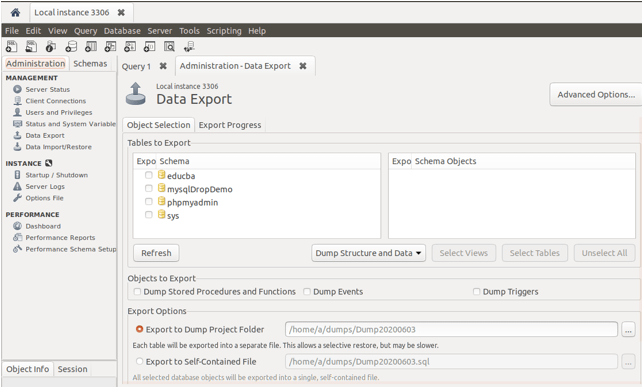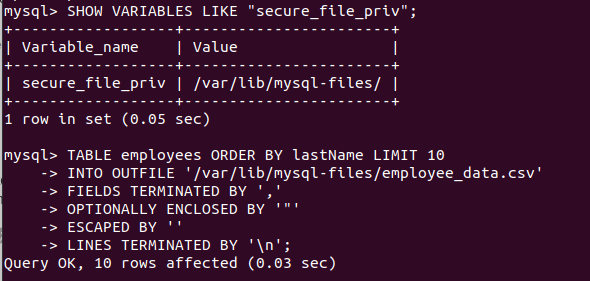
The above command will run silently with no output on screen.

Which makes the process more easier to transfer database to other system. Use mysqldump command line utility to perform a database backp. Also helped you to restore database from dump file. This tutorial help you to export MySQL database using system console. MySQL server provides console utilities to export and import databases. In case of mysql database migration, you can easily create a dump of database and restore it on target database server.
#Mysql dump sql command install
It is an opensource database server available to install on variety of operating systems To solve this, you’ll need to use a literal tab character in place of \t: sed "s/ /,/g" output.tsv > output.MySQL is an relation database management system to storing data in table format. On macOS and BSD, it’s not available, which leads to a mess of every lowercase “t” causing sed to insert erroneous commas. Note: the tab character \t is not standard. This will properly escape fields with quotation marks, which will solve the comma problem. If you’re entirely 100% certain that there are no commas in your TSV file (check with grep), you can replace the tabs with sed: sed "s/\t/,/g" output.tsv > output.csvīut if you have commas in your data, you’ll have to use a much longer regex: sed "s/'/\'/ s/\t/\",\"/g s/^/\"/ s/$/\"/ s/\n//g" output.tsv > output.csv You could simply replace each tab with a comma, which would work but would cause it to fail if there are commas in the input data. But it isn’t a CSV file, and converting it to one is complicated. Simply enter a query from the command line, and pipe it to a file: mysql -u root -e "select * from database " > output.tsvīecause MySQL output is separated with tabs, this is called a TSV file, for “tab-separated values,” and may work in place of your CSV file in some programs like spreadsheet imports. While you can use FIELDS TERMINATED BY ',' on the server to generate a comma-separated list, the MySQL CLI will separate with tabs by default. If you only have command line access to the MySQL instance, and not access to the server itself (such as when it’s not managed by you, in the case of Amazon RDS), the problem is a little trickier. Also, null values will be exported as \N, which is expected behavior, but if you’d like to change this you can modify the selection by wrapping ifnull(field, "") around your fields in your SELECT statement. Keep in mind that the exported CSV file doesn’t include column headings, but the columns will be in the same order as the SELECT statement. Which you can take and import directly into any spreadsheet program or other software. With the ENCLOSED BY setting, commas will be properly escaped, e.g.,: "3","Escape, this","also, this"

Once MySQL can export files, you should be able to run the query and output CSV files. Which will allow MySQL to read and write to /tmp/mysqlfiles/ (which you’ll have to create with mkdir). You can whitelist specific directories by editing your MySQL config file (usually located at /etc/my.cnf) to include:
#Mysql dump sql command code
This is a good thing if your code is vulnerable to SQL injection, any potential attacker would only have access to MySQL, and not the rest of the filesystem. This, by default, blocks read and write access from SQL queries. You’ll also need to make sure the secure_file_priv setting allows MySQL to access that directory.

You’ll need to make sure the user running MySQL (usually mysql or root) has ownership and write access to the directory. This will output a CSV file to /tmp/mysqlfiles/table.csv, or wherever you configured it to. If you have access to the server that MySQL is running on, you can export a selection with the INTO OUTFILE command.
#Mysql dump sql command software
Databases like MySQL and spreadsheet software like Excel support importing and exporting through CSV, so you can use CSV files to exchange data between the two.ĬSV files are plaintext, so they’re naturally lightweight and easy to export from MySQL. Comma Separated Values files (CSV) are a way of transferring data between applications.


 0 kommentar(er)
0 kommentar(er)
